P55 Extreme Overclockers: Check your sockets!
by Rajinder Gill on October 15, 2009 12:01 AM EST- Posted in
- Motherboards
We start with a picture.

The picture above is after our Core i7 870 (LGA-1156) processor was overclocked up to 5.19GHz using our cascade with a -102° Celsius evaporator head temperature under full-load. Processor VCC power draw at these frequencies is around 160W (this is possible only due to subzero cooling), as measured with a clamp meter installed at the 12V EPS power lead. Study the pictures closely and you should notice something peculiar. Keep in mind it comes from a CPU installed in the same type of socket from a particular manufacturer.
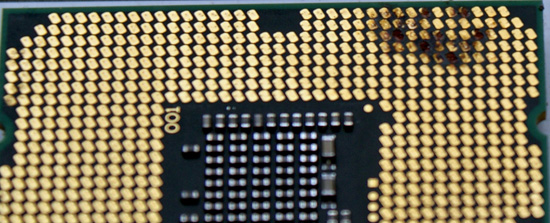
What happens after several extreme benchmark runs...
If you noticed something weird in the pictures then you understand the title of our article. We have what seems to be a potentially serious issue with proper socket loading on several P55-based motherboards when overclocking to the limit. We are of course not the only ones experiencing the problem as several of our overclocking peers have run into the same problem.
Normally we do not worry too much about mishaps during extreme overclocking testing as they are typically caused by factors outside of the supplier’s control. The overriding concern is that we have damaged every motherboard in our possession for the P55 overclocking (extreme) shootout as well as two very expensive i7/870 processors. These problems are the cause of a single component and are repeatable. As such, we thought we would provide details on current problems and will provide an update once all of the motherboard manufacturers affected have had a chance to properly respond.
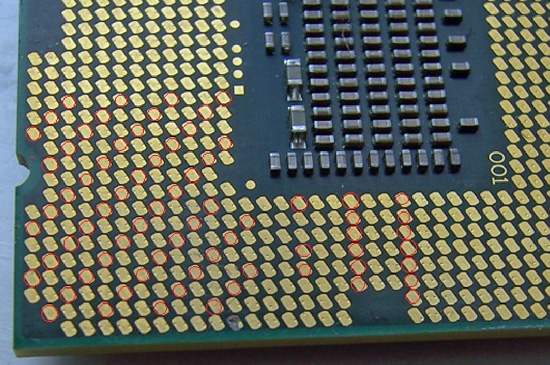
We draw your attention to the fact that the processor shown in this pictures exhibits signs of insufficient pin-to-pad contact (little to no contact) in what is a rather reproducible pattern with Foxconn manufactured 1156 sockets. As soon as an end-user mounts a CPU in a socket and latches the clamp mechanism, each pin should leave a notable mark on the associated pad.
We've marked locations where this does not seem to have happened, showing what appears to be a significant reduction in the number of VCC/VSS pins for proper power delivery, and certainly not at the right load line resistance. Damage resulting from highly overclocked use in these types of situations is not solely limited to the processor; let’s take a look at what happened to some of the motherboards in which these CPU were seated.
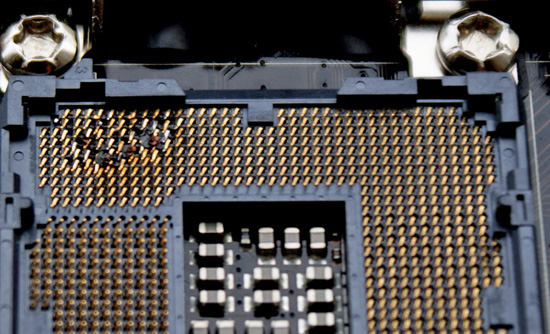

When Intel publishes socket specifications and design tolerances, it's up to component manufacturers to strictly adhere to them when designing, manufacturing, testing and ultimately selling their "compliant" components. Of course, that's not to say Intel could not have goofed when releasing their specification, leaving out a crucial tolerance or such. It could happen, but not likely. For the time being, let's assume that's not the case; seeing as how processors installed in sockets built by other companies have exhibited no such issue in testing to date.
At first glance, one might be inclined to think LGA-1156 based processors are intolerant of high-end overclocking, almost as if by design. This is correct to some extent; a quick glance at Intel’s white papers for socket 1156 CPU’s reveals that there are around 175 pads for VCC compared to over 250 for socket 1366 CPU’s. This means socket 1156 has around 66% of the current capacity of socket 1366, the caveat being that when overclocked, processors from both platforms draw similar levels of current.
When overclocked above 4GHz, processors from both platforms will draw around 15-16 amps via the EPS 12V rail to VCC, VTT and some of the other sub –system power rails under full 8 thread load from the Intel burn test (Linx). Assuming 85% PWM efficiency, we’re looking at power draw in the region of 130-140w to VCC on both platforms. The facts point toward tighter current handling tolerances for socket 1156 when compared to socket 1366, especially when it comes to non-connection of VCC/VSS power delivery pins.
Fortunately, we think we've been able to isolate pin to pad contact issues to one particular brand of parts. Physical inspection and end-user reports all but confirm the issues only affects sockets manufactured by Foxconn at this time. The only known alternative sockets in the wild are made by LOTES or Tyco AMP. We happen to have a couple of boards from EVGA using the LOTES/Tyco AMP sockets and MSI/DFI using the LOTES socket design, and thus far those boards have been issue free given highly similar operating conditions. In fact, we’ve managed to push our LGA-1156 processors further in heavy load tests on boards made using LOTES/Tyco AMP sockets than those made with sockets from Foxconn; something we’re not putting down solely to coincidence.
So far, EVGA is the only company we know that uses sockets exclusively from LOTES on their top-tier P55 boards - for example, the EVGA P55 Classified 200, model E659. This by the way may be the onus behind the decision to market the board’s “300% More Gold Content” socket statement as a purchasing option point. If you find yourself shopping for an EVGA P55 FTW, model E657, you've got a 50/50 chance of buying one with a Tyco AMP socket design (using a LOTES backplate), as opposed to one made solely with Foxconn's, the same goes for MSI and DFI who have batches of boards in the retail channel using LOTES sockets (although we're not entirely sure on socket specifics at this point). DFI told us earlier they have dropped usage of the Foxconn sockets completely until further notice. We hear the LOTES and Tyco AMP sockets are in short supply, which is probably why Foxconn's been able to fill the void in the market with what we believe to be a lower quality alternative for the extreme overclocker.
We took one of our damaged CPU’s and inserted it into one of the EVGA (LOTES/Tyco AMP) boards and took a few pics to show contact scoring and a side by side compare to the original Foxconn socket indents.
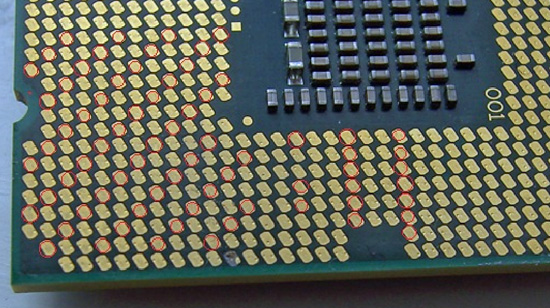
Foxconn 1156 Socket Installation
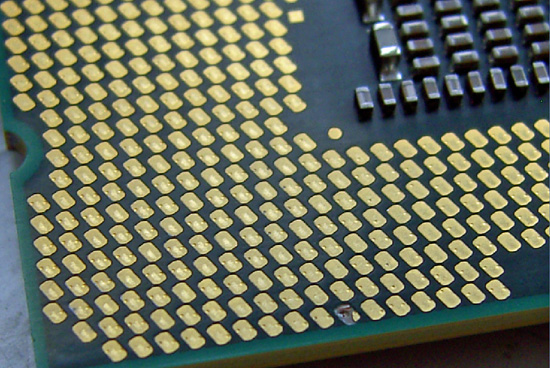
Tyco AMP / LOTES 1156 Socket Installation
Note how from a variety of angles certain pads show no evidence of contact from a Foxconn pin at all. Both the Tyco AMP and LOTES sockets have a larger pin/pad contact surface area leaving a slight scuff mark in the central area of each pad. In light of this, what we will say is that if you’re thinking of doing extreme overclocking on a board built using Foxconn's socket 1156, think again. Or, at least check your CPU for evidence of proper pin-to-pad contact.
We have not had any problems with air or water cooling overclocking up to 4.3GHz, although we do have a i5/750 that has developed a few dark pads after a thousand hours or so of constant overclocking. However, none of the boards have developed pin problems so we feel very safe in saying that any problems will probably occur only in extreme overclocking scenarios.
We also realize that partial responsibility for some of the less than acceptable CPU installations may be in fact due user installation errors. However, if users are screwing this up by doing nothing different than what they've always done when it comes to handling and installing LGA-type processors, then it's hard for us to find fault with the installer. Be aware of this situation and study the pin imprint on the CPU pads and make sure you have good contact on the VCC/VSS power delivery pads before pushing the system too hard.
















273 Comments
View All Comments
ClagMaster - Friday, October 23, 2009 - link
I agree with some of Neil's arguement, but respectfully reserve judgement about the technology linking the CPU to the socket (upward facing pins). I am not a technology purist as Neil where everything has to be just so. That's for academia. I am an engineer who understands "design compromises/tradeoffs" and the concept of "well enough" and "meets design specification". LGA 775 and LGA 1366 sockets worked well enough at stock and normal air cooled overclocking. And I am not aware of any problems with these sockets with Liquid N2 extreme overclocking.Both 775 and 1366 have the same latching and compression mechanisms while the LGA 1156 does not. All have the same pin upward facing pins designed to engage lands on the CPU. LGA 775 and 1366 works fine and LGA 1156 does not. What is different with LGA 775 and 1366 is the clamp engages the entire circumferential surface of the CPU resulting in a uniform distibution of compressive force. While the LGA 1156 clamps the CPU along the centerline of the CPU.
I did a KT problem analysis and came up with the following possiblities.
If Neil's assertion that 20% of the lands are not being engaged is true, then the Foxconn socket problem boils down to two possiblities:
1) The plastic ridge on the socket on which the CPU base rests and is restrained is too high by 1-2 mills and does not provide sufficient depression to engage pins that are lower than socket average. A telling indication of this is a random disperson of non-contact lands on the CPU.
2) The plastic ridge on the socket on which the CPU base rests is tilted, resulting in one side of the processor being higher than the other. This can also be from the clamping mechanism too since it engages the CPU at the centerline and provides a fulcrum for tilting. A clamping surface which is much longer will provide a more advantageous distribution of compressive force to correct tilting. A telling indication of this is one side of the processor will have more non-contact lands than the other. This is the problem I would place my money on if I were a betting man.
Neil, base on your observations, which is the telling indication? You are in a position give us THE DEFINITIVE ANSWER to this question. Is the non-contact lands you observed random or tilted in distribution? Which is it?
There is one way to prove this hypothesis.
Take a new motherboard (of a model which previously failed) with a FOXCONN socket and with a small tool such as a screwdriver and glue some emory paper of medium grit on the blade. Or use a small cuticle stone. Then lightly rub the plastic ridge down for 5-10 passes on each side (north, south, east, west) with the abrasive, being very careful not to touch the pins. This will take down about 1-2 mills of plastic ridge.
With canned air, blow away the loose plastic particles and mount the CPU. Remove the CPU and observe whether all of the pins are engaged. If you are satisfied all of them are engaged, completely assemble the computer and overclock it at the same extreme conditions the prior motherboard/CPU had failed. If it does not fail, then the problem is solved.
NOW THAT'S THE EXPERIMENTALIST APPROACH!
Not to mention this will answer the question about the Foxconn sockets.
neilmarzman - Sunday, October 25, 2009 - link
This is a well written response. I am glad the we have a smattering of mature people on the site. Your reasoning is well thought out, and I liked your open-minded yet skeptical attitude.The missing pin impressions on the lands were actually fairly grouped on the socket LGA1156. This might lend credence to the theory of poorly distributed clamping force, resulting in uneven contacts in groups. However, I can count at least 6 pads which are randomly located and are outside the area where there is grouping.
The trouble is that LGA1366 has similar distribution of pins. About 20% missing contacts, with about 12 pins which are randomly distributed.
Personally, I am really busy with my work to really investigate this problem. However, if there is genuine interest in the issue, I will have some of my colleagues in the Semiconductor lab, take a look at it and investigate it for you. You know in academia, the money is in short supply and we like to publish our work. So if they take it on, or if I in my lab do an investigation of the adverse EMI consequences of sharply bent pins. We will publish the results at the least. Since there is a huge amount of work that has already gone into the pure research of these EMI or EMC (if you want to be charitable);taking on a production chip for investigation (which does not add to knowledge which is already out there) is really not publishable material. So at this point, I cannot but only take a cursory look at this problem. However, this does not completely rule out the possibility. So I will see how it unfolds before I give you a commitment which is akin to wasting of my time. After all, I am not a consumer advocate, I am only a fair person--a good Samaritan, if you like.
We all know that just like water, or light, electrical field (and related currents) do not like sharp bends. They kind of spill over the bend in something akin to a slipping car, lot of eddies and reflection are created at these points with spillage of field as radiation. This causes major problems.
If I recall correctly, AMD came out with their 1 GHz processor in the June of 1999 with a 180nm process. In about a couple of years they were running at about 1.8 GHz with the same manufacturing process. I think Intel was able to squeeze out 2GH with its 180nm process with Willamette core. In a decade since then the die has shrunk to 32nm (I think 45nm production), electromagnetically (or electrically) every die-shrink by a factor of 2, should allow the frequency to double, so going from 180nm to45 nm, we should be looking at clock speeds in the range of 6~8 GHz.
Although the die has been shrinking like clockwork, they have not yet cracked 5 GHz ceiling. Putting spring loaded pins in a socket (having sharp bends) will not help their cause much. I feel comfortable in saying without equivocation that they are barking up the wrong tree with these LGA sockets.
For the overclockers; even if you could jack up the current, and cool the CPU to subzero temperatures, you will still experience instability fairly quickly. This instability, is not primarily due to heat generation, or the inadequacy of current supplies, or clock multipliers. It is the result of the much ignored EMI which corrupts data and is a tough nut to crack ;-)
I suppose that is all I have to add. I hope for the sake of the consumers that this problem is fully investigated by people whose job it is to do so, and they are paid to do just that.
Regards,
Neil
dia - Sunday, October 25, 2009 - link
You sir are a dunce.So now 20% of 1366 pads do not make contact either? 272 or so pads without contact? This is a canard of epic proportions.
You are looking at the Intel lab test imprints on the base of your CPU, not those from your socket. Look again and quit spreading FUD.
neilmarzman - Monday, October 26, 2009 - link
Do you what a "canard" means? Look it up! I think you should loose the adjectives and adverbs in your writing. Generally it is good way to objectively assess the substance of your writing, or lack thereof.dia - Monday, October 26, 2009 - link
Quit sidestepping the issue at hand and provide real evidence of your claims.Where is your evidence of 230 (socket 1156) or 270 (socket 1366) pads without contact?
Your story is false, so yeah it's a canard.
dia - Saturday, October 24, 2009 - link
He's probably busy tapping out his pipe and slapping the dandruff off his tweed jacket as we speak (sterotypes, dont ya just love 'em?). If he really does have the equipment at hand to do this, let him show us 20% of his CPU's pads not making contact with the socket pins. His posts are nothing more than static background noise until this evidence is shown. A man of his supposed calibre should have no problems in bringing the enlightenment of real physical proof to the masses.neilmarzman - Wednesday, October 21, 2009 - link
I have been reading Anandtech almost since it inception. At the beginning, the site was providing good information. Those were the times when these guys were earning their spurs. They would get the boards and microprocessors when they became available. Then there was a time when they grew big enough to snoop around at the expos and pick up on bits of news. They were still useful.Now that they have become fat and happy; they have become a conduit for the manufacturers. They are "embedded" just like the MSM press was "embedded" during the Iraq war. They are allowing themselves to be willingly used as conduits for drumming up support.
The shameless lead up to the release of P55 is a great example. These days they have access, they sign NDAs and get products before they released. Although they were able to drum up a lot of demand for the P55 platform (as indicated by its early prices), by providing users with tidbits of teasers and "pictorials", they never posted any meaningful results. I am 100% certain that they failed to do their job with integrity; why do we not have reviews for the higher end P55 boards? I think it is because they were unable to run the tests that they had hinted at, because the tests failed.
Take for example Gigabyte P55 UD6 board. It promised a lot, but putting in 6 memory sockets which could not be used was a disaster. The LGA 1156 is a slap on the face of electrical engineering 101. You do not transfer currents through point contacts (which are DC and and they do mention, when they are forced to admit), and you definitely do not use spring-loaded contacts for data pins (which they do not mention), as at these frequencies, impedances come into play.
I was not overclocking--personally I think of overclocking in the same league as some morons put in a 1000 HP engine in a Mustang GT, but do not have the knowledge to match the transmissions or strengthen the chassis, thus blowing up the cars--however, about 20% of the pins (power and data) did not contact the processor pads.
This site is still stuck with the power and overclocking; so they are only concerned with the power pins. The data pins are the more useful part of a processor (just like the transmission of a car)which are most affected because of tenuous electrical contact. It is here that EMI issues come in to play by messing if there are design errors in the hardware.
The Gigabyte board was not only dumping core, routinely, it was doing so at low frequencies. Intel, in their eagerness to make an end run around AMD, have created a dud. However, Anandtech people are still defending them by dishonest claims like, "the Gold pins are supposed to pierce the oxide layers". They got away with the LGA1300, because it was a novelty. component manufacturers were bound to cut corners; this is America after all. Just like Anandtech, every one has a right to turn a profit.
I knew it that Intel was going to crash and burn when they hired two of my laggard doctoral graduates around year 2000(who were better suited for a career in a community college than doing useful research).
Now, I see Anand writing about picking up phone and talking to Intel brass. I does not bother me that he is being manipulated by those people by whoring for access. Again it is their right to make as much as they can, but you have to keep and eye on who you get into bed with; they might give you a bad case of crabs. The damage these shenanigans are doing to his readership in addition to causing them monitory harm will come and bite them. Beware of the chickens coming home to roost.
I liked those times when these guys were using soldering paint to develop workarounds for unlocking the legitimate functions of processors. Now they might as well be on their payroll, and they probably are.
The thing is that this fat and happy state will not last long.
I am really disappointed in Anandtech,
Neil
Porksmuggler - Wednesday, October 21, 2009 - link
Anandtech still provides greater technical insight than the majority of hardware sites.You sound like a nutter with allegations of Anand "selling out to the man" It doesn't surprise me that you see the P55 as a failure. Anyone who could foresee Intel's downfall from the hiring of two doctoral graduates, must be saturated with hyperbole.
Your analogy to automobile customization is insulting to those that truly understand the tolerances of the hardware. Many overclockers have the knowledge to not "blow up" their systems. If you do not have the knowledge to safely overclock the hardware, its your prerogative to abstain, but passing judgment on the entire practice is idiotic.
neilmarzman - Wednesday, October 21, 2009 - link
Enlighten me a bit more. Did you read that they were my "students". If I don't know their real ability, then who does?Yes, overclockers are penny-wise pound foolish. BTW, I have know Intel before many of you were born; they were able to out-market Sun Microsystems Sparc processors, which were RISC. Full instruction set is a waste of time and money, however, if you have the money and unfair advantage owing to underhanded tactics, you end up winning, because more people in the world are foolish.
It is like QWERTY keyboard, or more Betamax and VHS, or for your generation HDDVD VS Blue Ray; when both these formats are destined to the dustbin due to better control over downloadable data, increasing bandwidths, and better encryption; in a few years you will be hard pressed to find any, just like the venerable 8 track. Clueless people do strange things. P55 and LGA1156 will put a major dent in the Intel, the motherboard manufacturers, the component manufacturers, and the reviewers.
In reading your mail critically, I notice a glaring lack of substance. You have not provided a single technical argument--even of a general nature--to support the LGA packaging; I presume that you never had the advantage of serious schooling. I am also guessing that you probably own a souped up car or two(with broken trannies) and a few burnt our overclocked computers with a lot of LEDs ;-)
However much I understand your passion, I would still prefer that you stick to the issue at hand: why has anandtech not posted the data on the the boards that they have been "testing" for months? The NDAs are not in force anymore, so what is the excuse? Where are the results?
Next time, be careful when using adjectives. I am old and experienced, and I am quite capable of upping the ante. However, it is better to stick to the real issues at hand. Last I looked this was supposed to be a technical site, not a Dear Abby column, so keep you emotions in check.
Neil
1stguess - Thursday, October 22, 2009 - link
I'm not an expert so i cannot affirm whether pinpoint contact on the pads is the big issue. I do however like hearing a voice that is not a afraid to take an informed stance.While some posters might take an offense to your style of not pulling any punches Neil, It makes for some really entertaining reading. "Broken trannies", "clueless people do strange things", haha.
So let me ask, you think that both Foxconn and Intel are complicit in this p55 failure?
BTW I refunded my p55 platform in exchange for a 1366 board & i7 920, but still have an aversion to buying Foxconn even on this platform. Might need therapy.